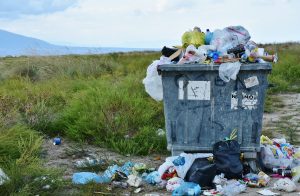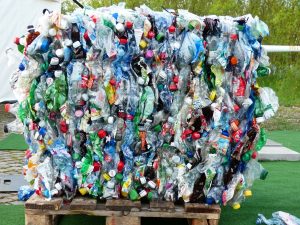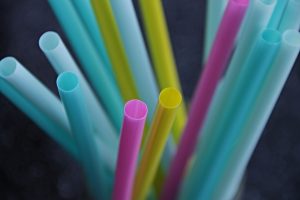Microplastics; An Unwanted Food Ingredient
Posted by Phil Heler, MD on June 5, 2019Microplastics have saturated our world and entered the food chain. and ultimately, our bodies.
What is Plastic?
Today’s piece is about Microplastics. Plastic is a word that originally meant “pliable and easily shaped.” As a word it is now used to describe a category of materials called polymers. Synthetic polymers are made up of long chains of atoms, arranged in repeating units, much longer than those found in nature. It is the length of these chains, and the patterns in which they are arrayed, that make polymers strong, lightweight, and flexible. In other words, it’s what makes them ‘plastic’. These properties make synthetic polymers exceptionally useful, and since we learned how to create and manipulate them, polymers have become an essential part of our lives. Over the last 50 years plastics have saturated our world and changed the way that we live. World production has increased exponentially—from 2.3 million tons in 1950, it grew to 162 million in 1993 and to 448 million by 2015. That is a lot of plastic, how and where we dispose and recycle it has become a huge problem. Public awareness of some these issues has increased with documentaries such as Blue Planet presented by the irrepressible David Attenborough. Research by Waitrose found that 88% of respondents to a survey who saw the final episode of BBC’s Blue Planet II about the effect of plastics on our oceans had since changed their behaviour. We have all recently experienced new policies (5p per bag) on single-use plastic bags at supermarkets and I, like many people, now have plastic bags full of plastic bags in my car (or is it just me!). But this is just the tip of the iceberg!
Since the 1950s, around 8.3 billion tons of plastic have been produced worldwide and there has been a huge shift in perception as ecological concerns escalate. It is estimated that only 9% of a huge total has been recycled. A report by the Guardian newspaper recently estimated that 1 million plastic bottles are bought around the world every minute, and this number is set to increase by another 20% by 2021. The same report suggested that more than 480 billion plastic drinking bottles were purchased in 2016 across the world — up from 300 billion a decade ago. According to official statistics less than half of these bottles purchased in 2016 were recycled — with just 7% of those collected turned into new bottles, and the rest ending up in landfill sites or the ocean. And this is just bottles! One of the many issues is that some of these plastics are beginning to unwittingly enter our food chain.
What are Microplastics?
Salt and pepper are normal ingredients we have with our meal; however, you may not be aware that seemingly also extends to microplastics as well! The average person eats 70,000 particles of microplastic each year. That works out to about 100 bits of microplastic over the course of just one meal, according to a study published in the journal titled ‘Environmental Pollution’ in June 2018. Microplastics are tiny pieces of plastic ranging from 5 millimetres down to 100 nanometres in diameter. Sunlight, bacteria, wave motion, seasonal changes, and other processes can change the properties of these microplastics. Collectively, these weathering processes slowly degrade microplastics to micro or nano-sized particles (unless they have already entered our seas in sediment as microplastics) . Microplastics are components of diverse products ranging from fishing equipment (drift lines), drink bottles, synthetic textiles, car tyres, paints, cosmetics and personal care products (e.g. facial cleaners, bath gels, toothpaste), and electronic equipment among many examples.
These small fragments of microplastics are now are now found almost everywhere in the oceans, from sediments on the deepest seafloor to ice floating in the Arctic. The problem is that these ocean microplastics are entering the food chain and, ultimately, our bodies. One of the first studies to estimate our potential exposure to microplastics through eating seafood was done in 2014 by two researchers Van Cauwenberghe and Janssen (also published in ‘Environmental Pollution’). They calculated that in European countries with high shellfish consumption, consumers ingest up to 11,000 microplastic particles per year, whereas in countries with low shellfish consumption, consumers ingest an average of 1800 microplastics per year (big difference!). Other potential sources are sea salt. One kilogram of sea salt can contain over 600 microplastics. If you eat the maximum daily intake of 5 grams of salt, this would mean you would typically consume three microplastics a day! Not a nice thought!
Where do Microplastics end up?
According to World Economic Forum, just 10 rivers across Asia and Africa carry 90% of the microplastic that ends up in the oceans. This study stated that eight of these rivers are in Asia: the Yangtze, Indus, Yellow, Hai He, Ganges, Pearl, Amur, and Mekong. Two of the rivers can be found in Africa: the Nile and the Niger. The WEF added that the two things all the rivers named have in common is a high population living in the area, as well as a poor waste management system. A study conducted by the University of Queensland in Australia, based on data collected since the late 1980s, found that Green sea turtles for instance now ingest twice the microplastics they did 25 years ago. According to the United Nations, ingestion of plastic kills an estimated 1 million marine birds and 100,000 marine animals each year.
Perhaps the biggest known source of non-marine microplastics that we consume is probably bottled water. When researchers examined a variety of types of glass and plastic water bottles, they found microplastics in most of them. Single-use water bottles contained between 2- 44 microplastics per litre, while returnable bottles (designed for collection under a deposit scheme) contained between 28 and 241 microplastics per litre. These microplastics probably came from packaging, which means we could be exposing ourselves to more of them every time we fill up a plastic bottle in order to reduce waste. There is also evidence that microplastics in food come from indoor dust. A recent study estimated that we could get an annual dose of almost 70,000 microplastics from the dust that settles on to our meals. Presumably some of this comes from fibres from clothing such as fleeces etc. Apart from microplastics there is also the issue of recycling.
Recycling Rates in the UK
Recycling rates in the UK have presently fallen to around 44%, despite the target set at 50% by the year 2020. We send 22 million tons of waste to landfill every year. The UK recycling rate for Waste from Households was marginally better in 2016 at 45.2%, increasing slightly from 44.6% in 2015 and clearly these values should increase year on year. But this is only an average. Some of the worst councils are in London where, for example, Westminster burned 82% of all household rubbish (what a sense of irony!). The Western Riverside Waste Authority, which covers Hammersmith and Fulham, Kensington and Chelsea, Lambeth and Wandsworth, incinerated 79% as did Lewisham and Tower Hamlets. Slough, Kirklees, Sunderland, Portsmouth and Birmingham councils all incinerated at least 70% of all plastic, paper and household rubbish. Even if we do meet our recycling targets you may not realise that currently most of our recycling actually happens in other countries! According to WWF, the cost to recycle plastic in Europe is almost double what that plastic is worth.
We have Traditionally Relied on Asian Countries for Our Recycling
We have traditionally relied on Asian countries to undertake this role for us. In might surprise you that until recently China was processing two thirds of our plastic waste! It is a plain fact that wealthy nations sell their recycled plastic scrap (up to 81% in the case of America) to Asia simply because it’s more economical and easier to ship it around the world than to process it at home. In Asia, labour is cheap and environmental standards present a lower hurdle to mount. In the 1990s, as China moved to become the world’s leading manufacturer, it began buying recycled plastics from the United States, Europe, Japan, and other nations. It developed the ability to process these materials into goods, but much of it was low quality and added to China’s mounting health and environmental problems. Imported plastic waste added, on average at the time, another 12% to the plastic waste China already generated domestically every year. In 2016, that translated into 8.1 million additional tons on top of the 67 million tons of domestic waste created internally, leading to complications and difficulties in waste management. At the start of 2018, China acted by banning imports on 24 types of recyclable materials, including recycled plastics, as part of an environmental reform movement. After 25 years of importing 106 million metric tons (or 45% of all plastic waste) China refused to buy any recycled plastic scrap that wasn’t 99.5% pure. This move upended a $200 billion global recycling industry and threw the rest of the world into turmoil.
Much of this plastic made its way to China’s maritime neighbour, Malaysia, which imported more than 754,000 metric tons ( 830,000 tons) of plastic waste from January to June of 2018, according to Greenpeace. However, this looks unlikely to continue. Plastic has been in the news again this week after Malaysia was the latest country to scrutinise plastic imports (due to lack of purity) from the UK, US, Canada and Australia. Malaysia will send back some 3,000 metric tonnes of non-recyclable plastic waste to countries including the UK, US, Canada and Australia ‘in a move to avoid becoming a dumping ground for rich nations’. Ms Yeo Bee Yin (who has a very long title as Malaysian ‘Minister of Energy, Technology, Science, Climate Change and Environment’) said Malaysia and many developing countries have become new targets after China banned the import of plastic waste. Ms Yeo said China’s plastic waste ban had “opened up the eyes of the world to see that we have a huge garbage and recycling problem”. “Citizens in rich nations diligently separate their waste for recycling but the rubbish has ended up being dumped in developing nations where it is recycled illegally, causing environmental and health hazards” she said. “We urge the developed countries to review their management of plastic waste and stop shipping the garbage out to the developing countries,” she said, calling such practices “unfair and uncivilised”. A big part of the problem is that sending material abroad for recycling doesn’t necessarily mean it gets recycled. Rogue waste firms in receiving countries such as Malaysia operate illegally, sifting through the rubbish, taking out the economically valuable material and burn or even dump the rest causing untold environmental harm. The waste industry is notorious in some places for its links with criminal activity. The global illegal waste trade is estimated by the UN to be worth between £8bn-£9.5bn a year.
The Call to Ban Single Use Plastics
What can we do? On average, we each use 53 kilograms of plastic a year. Single-use plastics have become so ubiquitous it’s hard to imagine doing things any other way. Somewhere along the line we’ve constructed a system in which it makes more sense to mine the oil to make the plastic cutlery to use once and throw away, than it does to put our steel cutlery in a dishwasher. While re-imagining a world without single-use plastics might be hard, doubling the world’s plastic pollution by 2030 will be worse. A recent report by the World Wildlife Fund (WWF) backs a global ban on single-use plastic to curb pollution and asks businesses to be responsible for how their products are disposed of or recycled. About 40 per cent of plastics we consume today are single-use — things like cutlery, plates, food containers, electronics packaging. Single-use plastics simply must go, according to Richard Leck, WWF’s Head of Oceans and Sustainable Development. “In terms of the calls to action, absolutely the ban around single-use plastics is very important,” he said. “There needs to be incentives for producers to use products that aren’t single use.”
The European Commission is now phasing out plastic cotton buds, cutlery, plates, straws and drink stirrers in all member states. The EU is waging war against plastic waste as part of an urgent plan to clean up Europe’s act and ensure that every piece of packaging on the continent is reusable or recyclable by 2030. Speaking to the Guardian and four other European newspapers, the vice-president of the commission, Frans Timmermans, said Brussels’ priority was to clamp down on “single-use plastics that take five seconds to produce, you use it for five minutes and it takes 500 years to break down again”. Legislation is being put in place to ban single-use plastic bottles with detachable lids. The commission said it will promote easy access to tap water on the streets of Europe to reduce demand for bottled water, and they will provide member states with additional guidance on how to improve the sorting and collection of recyclable plastic by consumers.
Whilst policy on plastic waste is paramount the other question scientists have yet to answer when it comes to microplastics in our food is how much harm they actually do. Understanding the processes and mechanisms involved in the entry and assimilation of microplastics in our bodies and their potential effects on human health is a priority research area.



